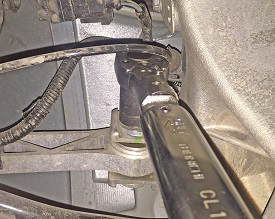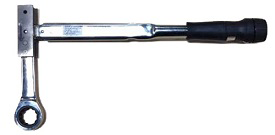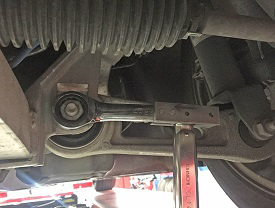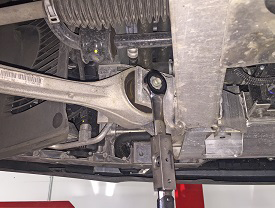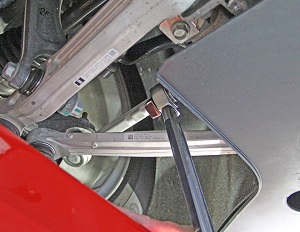FRT No: 31000100
Note: This procedure is not specific to a particular alignment machine. Follow the
alignment equipment manufacturer's instructions for additional information and safety
instructions.
Special tool(s) required for this procedure:
|
Supplier
|
Part Number
|
Description
|
| Tesla |
1054170-00-A |
Alignment Torque Tools Kit |
| Tesla |
1079459-00-A |
22 mm Crow Foot Wrench |
-
Perform a four wheel alignment check (refer
to procedure).
Caution: Do not bump or pull
on the vehicle for the remainder of this procedure; this could bring the ride height
values out of specification.
Note: Follow the alignment equipment
manufacturer's instructions when performing the following 4 steps.
Caution: Only fully tighten suspension
nuts and bolts when the vehicle is on a 4-post lift and the suspension is in the
ride height position.
Note: If available, use the Alignment Torque Tools Kit
when performing the following 4 steps.
Note: Refer to the
Wheel Alignment section of this manual for
the latest alignment specifications.
Caution: The following 4
steps must be completed in the order shown.
-
Adjust the rear toe as required:
-
Remove the mid aero shield (refer to
procedure).
-
Attach a 19 mm, 1/2 in. drive socket and Tohnichi ratchet head to the
Tohnichi torque wrench handle.

Caution: If a socket
wrench with an extension is used to adjust rear toe, the extension might
contact the suspension height sensor bracket, causing the bracket to bend. A
bent bracket causes incorrect vehicle ride height at the affected
corner.
-
Set the torque wrench to 80 Nm.
-
Adjust the rear toe as necessary.
-
Air suspension only: In Toolbox, select Cycle Heights High -->
Normal. Ensure that the toe is still within specification.
-
Air suspension only: In Toolbox, refer to the Ride Height
panel. If any value is more than +4 or less than -4, select Cycle Heights
High --> Normal again.
-
Reinstall the mid aero shield.
-
Adjust the front camber as required:
-
Attach the 22 mm custom ratcheting wrench to the Tohnichi torque wrench
handle.
-
Set the Tohnichi torque wrench to 140 Nm.
Caution: If the
alignment torque tools are not available, set a standard torque wrench to
130 Nm.
-
Adjust the front camber as necessary.
Note: It is not necessary to
remove the front aeroshield if the alignment torque tools are used to
perform this step.
-
Adjust the front caster as required:
-
Attach the 22 mm custom ratcheting wrench to the Tohnichi torque wrench
handle.
-
Set the Tohnichi torque wrench to 101 Nm.
Caution: If the
alignment torque tools are not available, set a standard torque wrench to
130 Nm.
-
Perform a caster sweep.
-
Adjust the front caster as necessary.
Note: It is not necessary to
remove the front aeroshield if the alignment torque tools are used to
perform this step.
-
Adjust the front toe as required:
-
Attach the crow foot wrench to a torque wrench, inline with the wrench
handle.
-
Set the torque wrench to 62 Nm.
-
Adjust the front toe as necessary.
Note: It is not necessary to
remove the front aeroshield if the alignment torque tools are used to
perform this step.
Coil suspension only: If
the vehicle cannot be aligned to specification, check the ride height and compare to the
specifications at:
. If the ride height is out of specification, inspect the
suspension for damaged components.
-
Check the steering wheel angle displayed on the touchscreen. If it is not 0.0
degrees, turn the steering wheel so that the steering wheel angle is 0.0 degrees.
-
Readjust front toe if turning the steering wheel caused it to be out of
specification.
-
Air suspension only: In Toolbox, select Cycle Heights High -->
Normal. Ensure that the toe is still within specification.
-
Air suspension only: In Toolbox, refer to the Ride Height panel. If
any value is more than +4 or less than -4, select Cycle Heights High -->
Normal again.
-
Check the alignment machine to ensure that all alignment parameters are still
within specification.
-
Transfer the PDF of the alignment results from the alignment machine and attach it
to the repair order.
-
Remove the brake pedal depressor.
-
Reinstall all slip plate pins and turn plate pins.
Tip: Install the forward
slip plate pins before installing the rearward slip plate pins.
-
Remove all 4 alignment optical targets.
-
In Toolbox, run the ESP Steering Angle Sensor Calibration.
-
Disconnect the laptop from the vehicle.
-
Enter the vehicle.
-
Press the brake pedal and shift into Park.
-
Remove the wheel chocks.
-
Remove the vehicle from the alignment rack.
-
Test drive the vehicle.

